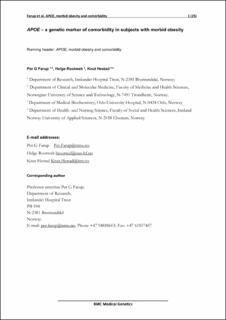APOE – a genetic marker of comorbidity in subjects with morbid obesity
Peer reviewed, Journal article
Accepted version
Permanent lenke
https://hdl.handle.net/11250/2729865Utgivelsesdato
2020Metadata
Vis full innførselSamlinger
Originalversjon
BMC Medical Genetics. 2020, 21 (146), 1-9. https://doi.org/10.1186/s12881-020-01082-2Sammendrag
Background: In population-based studies, the genetic variability of the APOE E alleles have been associated with health outcomes. Health problems are common in subjects with obesity. This study explored associations between the APOE E alleles and comorbidity in subjects with morbid obesity. Methods: The study included consecutive subjects referred for evaluation of bariatric surgery with morbid obesity (defined as BMI > 40 or > 35 kg/m2 with complications related to obesity). The subjects followed a conservative weight loss program for 6 months before surgery and had a follow-up visit 12 months after surgery. Demographic data and a set psychosomatic scores (musculoskeletal pain, WHO-5 Well-Being Index, Rosenberg Self-Esteem Scale, Hopkins Symptom Check-list 10; Epworth Sleepiness Scale, and Fatigue Severity Scale) were collected, and blood samples were analysed for haematological and biochemical parameters and APOE alleles. Results: One hundred and forty subjects (men/women: 32 (23%)/108 (77%) with mean age 43.0 (SD 8.7) years and BMI 42.1 (SD 3.8) kg/m2 were included. One hundred and eight and 92 subjects had data after conservative treatment and 12 months after surgery, respectively. The prevalence of the APOE alleles were: E2E2: 1 (0.7%), E2E3: 13 (9.3%), E2E4: 4 (2.9%), E3E3: 71 (50.7%), E3E4: 47 (33.6%), and E4E4: 4 (2.9%). The prevalence rates were as anticipated in a Norwegian population. The weight loss during conservative treatment and after bariatric surgery was independent of E allele variability. E2 was associated with a significant or clear trend toward improvement of all psychosomatic disorders. There was a significant fall in CRP during the two treatment periods with weight loss. E2 and E4 were significantly associated with high and low CRP, respectively, but no associations were seen between CRP and comorbidity. Conclusions: The most marked finding was the association between E2 and improvement of all psychosomatic disorders. The positive and negative associations between CRP and E2 and E4, respectively, could indicate effects on inflammation and immunological reactions.
